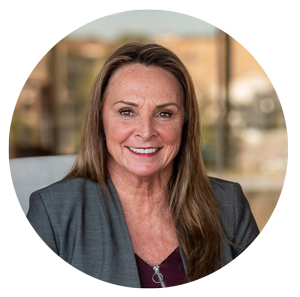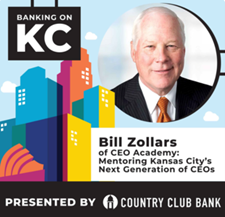The Bottom Line - Banking on People

Banking On People
What is the Status of Your People Portfolio?
When business owners and executives talk about portfolios, most think about assets, loans, or client relationships. But another portfolio is just as critical, and often underappreciated: your people portfolio.
Let me pose this question for your consideration, since it’s one I often ask myself and our leadership team: How much time are you spending on your people portfolio?
Not just managing payroll or compliance, but truly investing in, nurturing, and evolving the talent that fuels your business?
It’s a question worth answering. Whether you’re a bank, a manufacturer, a service provider, or a tech startup, your people are the engine of your success. And engines don’t run well without tune-ups and maintenance.
At Country Club Bank, we actively track turnover because turnover is expensive. Using conservative figures, even a modest turnover rate can add up to a seven-figure expense.
And while some of that may be intangible soft costs, you can see real dollars walking out the door in terms of training expenses, lost productivity, and new recruiting or replacement expenses.
But zero turnover isn’t the goal either. Healthy turnover means people are growing, opportunities are evolving, and fresh perspectives are being added. The optimal balance lies in the middle. And achieving that optimal balance requires strategy and tactics.
Too often, leaders assume people will manage themselves. After all, the team seems fine. But the truth is, talent doesn’t thrive passively; it needs to be cultivated. Especially now, when the way we work has changed dramatically, but the way many companies hire has not.
For example, the days of looking strictly at past job titles, industry-specific experience, or tenure at a single company are fading. Today’s workforce is more mobile, project-based, and driven by purpose than position. And frankly, some of the best people we’ve hired didn’t come from banking. They came with highly transferable skills such as curiosity, a willingness to learn, and emotional intelligence (EQ).
That last part, EQ, is something we emphasize with our interns and managers alike. You can have a master's degree and still miss the mark if you don’t have the emotional awareness to connect with people. Conversely, someone with average credentials but high EQ can develop skills, build trust, and deliver lasting value.
We also embrace stretch opportunities within our organization. If we can’t promote someone today, we can still give them a new challenge by plugging them into a high-visibility project outside their department. Growth isn’t always up. Sometimes, it’s sideways.
Finally, hiring speed matters. We’ve adopted text and video recruiting to keep pace with candidates who may not use email as much as previous generations. When it comes to hiring in today’s marketplace, speed is a competitive advantage.
Your people aren’t just part of your business, they are your business. And when you give the same care and commitment to them as you give to your financials, you’re investing in more than your business, you’re investing in your future.

— Toni Walsh, Chief Human Resources Officer, Country Club Bank, Member FDIC
Economic Insights
Mid-year reality check: Inflation stabilizes, Fed holds for now
The U.S. economy continues to send mixed signals as it enters the second half of 2025. While inflation is trending in the right direction, growth is slowing, the labor market is softening, and unsettled tariff policies continue to stoke uncertainty for business leaders and consumers alike.
Inflation data for May shows headline consumer prices up 2.4% year-over-year, holding fairly steady from April. Core inflation, which excludes volatile food and energy prices, remains at 2.8%, its lowest level in over three years.
While these figures suggest inflation is continuing to cool, it’s not enough to signal “all clear” for policymakers. Fuel costs are easing (but Mideast tensions could quickly change that), and grocery prices ticked slightly higher. New import tariffs—10% on average—are expected to reverse some of this progress, putting upward pressure on prices in the coming months.
In response, the Federal Reserve has maintained its cautious stance, leaving rates unchanged at 4.25% to 4.50%. The Fed’s latest projections include two quarter-point cuts later this year, with one coming as soon as July during the next Board meeting. The market is currently pricing in 18% odds of a cut in July and 78% odds of a cut in September.
Chair Jerome Powell acknowledged that “unusual uncertainty” around trade policy, global markets, and consumer behavior complicates the path forward. For businesses and consumers, this means borrowing costs may remain elevated a bit longer than hoped.
The labor market is also showing signs of cooling. The economy added 139,000 jobs in May, slightly down from April’s revised figure. The unemployment rate held steady at 4.2%, but wage growth, up 3.9% year-over-year, continues to outpace inflation, offering positive support for U.S. households.
Meanwhile, economic growth has slowed. The first quarter of 2025 saw a contraction in GDP for the first time in three years. While inventories and exports masked some underlying demand weakness, the broader trend points toward slower momentum.
The Fed now predicts just 1.4% GDP growth for the year. This is a downward revision from its previous estimate of 1.7%.
The implications for business owners and commercial banking clients are clear: margin pressure may increase, hiring may become more selective, and investment decisions could face new delays.
Rising tariffs and global uncertainty are already prompting many companies to rethink supply chains, pricing strategies, and capital expenditures.
Bottom Line: There are still levers to restore stability. Easing trade tensions through revised agreements, exercising greater fiscal discipline, and implementing thoughtful, responsive monetary policy can help rebuild confidence.
In the meantime, innovative businesses are focusing on managing costs, maintaining access to credit, and investing in core strengths that will carry them through a slower period.
The Fed remains cautious, but the growing consensus is that current rates remain well above neutral and can be adjusted without jeopardizing price stability. Clarity and certainty continue to be elusive, while predictions for leading indicators remain neutral to positive for the second half of 2025.

— Marcus Scott, CFA, CFP®, Chief Investment Officer (CIO) for Country Club Trust Company
CFA® and Chartered Financial Analyst® are registered trademarks owned by CFA Institute.
Certified Financial Planner Board of Standards Inc. (CFP Board) owns the certification marks CFP®, CERTIFIED FINANCIAL PLANNER®, CFP® (with plaque design), and CFP® (with flame design) in the U.S., which it authorizes use of by individuals who successfully complete CFP Board's initial and ongoing certification requirements.
The opinions and views expressed herein are those of the author and do not necessarily reflect those of Country Club Trust Company, a division of Country Club Bank, or any affiliate thereof. Information provided is for illustrative and discussion purposes only; should not be considered a recommendation; and is subject to change. Some information provided above may be obtained from outside sources believed to be reliable, but no representation is made as to its accuracy or completeness. Please note that investments involve risk, and that past performance does not guarantee future results.
Investment products are not insured by FDIC/other federal agencies; are not deposits of/nor guaranteed by CCB or any of its subsidiaries/affiliates; and may lose value.
Partnership Profile
SnapIT Develops the Tech Workforce of the Future—With Capital from Country Club Bank
When CEO Neelima Parasker founded SnapIT, she brought over 15 years of global leadership experience in enterprise technology. But what ultimately inspired her wasn’t corporate strategy but community impact.
 “I started volunteering in underserved communities around Kansas City,” said Parasker. “And I was shocked. In our city, many inner city kids and young adults couldn’t access the tech education and resources I had assumed were universal. That changed everything.”
“I started volunteering in underserved communities around Kansas City,” said Parasker. “And I was shocked. In our city, many inner city kids and young adults couldn’t access the tech education and resources I had assumed were universal. That changed everything.”
Today, SnapIT is not only delivering enterprise technology services and staffing solutions to major clients, including Evergy, Federal Reserve Bank, and various federal agencies, but it’s also training and placing hundreds of aspiring technologists through its flagship SPRNT® Lab program. And thanks to a trusted banking relationship with Country Club Bank, SnapIT is scaling this impact across 10 states and counting.
A Workforce Model Built for Fairness and Scale
SnapIT’s SPRNT Lab is more than a training curriculum. It’s a whole career development pipeline designed to help individuals of all ages, from recent high school grads to career-switchers in their 40s and 50s, confidently enter the tech workforce.
The model is structured in four steps:
1. Tech Assessment: A 30-minute digital quiz identifying students' aptitude and alignment for tech careers.
2. Core Tech Training: Nine weeks of live, instructor-led coursework in disciplines like Java, Python, cloud engineering, cybersecurity, and more.
3. Professional Skills + Agile Certification: Real-world preparation with mentoring and credentialing.
4. On-the-Job Experience: Twelve weeks of hands-on project work to build a strong portfolio and transition into employment via Registered Apprenticeships.
Programs are no-cost to most students through workforce agency partnerships, and SnapIT has trained over 2,000 individuals to date. With a graduation rate of 93% and nearly 98% credential-eligible, the outcomes are among the strongest in the industry. Students are also supported with laptops, exam vouchers, and access to career mentors.
 “Our goal is to lower the barrier of entry to high-quality tech jobs so employers get more potential talent to hire, and individuals have the chance to grow themselves and their opportunities to enter the tech industry,” said Parasker. “This is not just about training, it’s about transforming a jobs marketplace, and ultimately, an entire industry.”
“Our goal is to lower the barrier of entry to high-quality tech jobs so employers get more potential talent to hire, and individuals have the chance to grow themselves and their opportunities to enter the tech industry,” said Parasker. “This is not just about training, it’s about transforming a jobs marketplace, and ultimately, an entire industry.”
From Classroom to Contract
SnapIT’s mission goes beyond its own hiring needs. The company now serves as a talent pipeline for other employers, with flexible options for direct hiring or placement through SnapIT’s recruiting arm. In fact, employers can often qualify for grants or incentives when hiring registered apprentices trained through the company’s Department of Labor–recognized program.
“We want to help companies solve real tech challenges by unlocking talent that’s often overlooked,” Parasker said. “Whether placing five developers on a federal contract or helping a local business upskill its team, we’re meeting the market needs where they are.”
This flexibility has earned SnapIT trusted client relationships across government, healthcare, and enterprise sectors. It also enabled them to retain high-profile partnerships even as major clients like Cerner have evolved through mergers and acquisitions.
Banking on Trust and Tailored Support
As SnapIT’s reach has expanded, so has the need for a banking partner that understands the pace and complexity of a fast-growing tech company. In 2023, Parasker transitioned her business to Country Club Bank, giving her peace of mind and a solid banking partner for future growth.
“I wasn’t even looking to change banks, but I needed a partner who could see the full picture and the future,” Parasker said. “Country Club Bank stepped in when it mattered most. They believed in me, our business model, and the communities we serve.”
SnapIT now relies on Country Club Bank for its line of credit, deposit accounts, and day-to-day treasury support. And with the recent announcement of Country Club Bank’s pending merger with FNBO, SnapIT will have access to an even greater selection of products, services, technologies, and capital. As SnapIT continues to grow, the combined infrastructure, support, and lending power of Country Club Bank and FNBO will be more than enough to sustain SnapIT’s future capital needs.
Parasker credits Mary O'Connor, EVP, Creative & Brand Management, and Janelle Aubrecht, VP of Commercial Lending at Country Club Bank, and their team for being accessible, transparent, and relationship-driven, qualities that mirror Parasker’s approach to leadership.
“It’s not about transactions, it’s about trust,” Parasker said. “And that’s exactly what we’ve gained with Country Club Bank.”
Banking on KC Podcast
Tune In: Bill Zollars of CEO Academy on Training Kansas City’s Next Generation of CEOs
What does it take to lead with confidence and make a lasting impact?
On this episode of Banking on KC, host Kelly Scanlon sits down with Bill Zollars, Co-Founder of the CEO Academy of Kansas City, to explore how the Academy is shaping the next generation of leaders through practical experience, powerful mentorship, and a deep commitment to community.
Tune in to hear why the Academy was founded, how it builds on Kansas City’s leadership legacy, and what aspiring CEOs can gain from learning directly from those who’ve walked the path before them. Listen to the full episode here.

Fraud Awareness & Prevention
What Businesses Need to Know About Fraudulent BOI Filings
 As businesses across the U.S. work to comply with the Corporate Transparency Act (CTA) and file Beneficial Ownership Information (BOI) with FinCEN, scammers are exploiting the process, targeting companies with deceptive forms, false fees, and fake agencies.
As businesses across the U.S. work to comply with the Corporate Transparency Act (CTA) and file Beneficial Ownership Information (BOI) with FinCEN, scammers are exploiting the process, targeting companies with deceptive forms, false fees, and fake agencies.
In a recent alert, the Financial Crimes Enforcement Network (FinCEN) warned of fraudulent schemes using its name and insignia to trick businesses into paying unnecessary filing fees or disclosing sensitive company information.
The good news: BOI filings can be completed directly with FinCEN for free at FinCEN.gov. But you need to be vigilant.
Learn to spot red flags, verify official communications, and file safely and accurately. Stay informed, stay compliant, and avoid paying for services that don’t exist. Read the full article here.